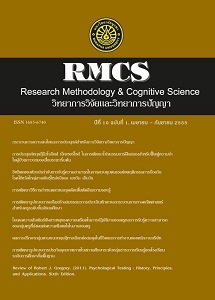การพัฒนารูปแบบการประกันคุณภาพภายในสถานศึกษาระดับกลุ่มสาระการเรียนรู้ของโรงเรียนระดับ การศึกษาขั้นพื้นฐาน
Main Article Content
Abstract
Development of Quality Assurance Model for Subject Groups in Basic Education
Sasitron Buathong, Suwaporn Semheng, Sunan Somkosum and Komsorn Wongrugsa
Srinakharinwirot University, Thailand
The aim of this research was to develop an internal quality assurance model for subject groups in basic education. The research methodology was divided into two parts. First, the creation of the internal quality assurance model for subject groups in basic education. This was accomplished by analyzing data from previous research; and reviewing the quality assurance process of education in the schools. The samples consisted of educational administrators, personnel responsible for quality assurance, and head of eight subject groups in basic education. The sample size was 38 schools consisting of 10 individuals from each school, with a total of 380 people. They were divided into 2 groups; 4 schools receiving the Focus Group Interview technique, and 34 schools receiving questionnaires. Second, the study of the efficiency and effectiveness of the internal quality assurance model for subject groups in basic education which was carried out by conducting a pilot test on one school. The efficiency of the model was studied in four dimensions; feasibility, propriety, utility, and accuracy. The effectiveness of the model was determined from the Self-Assessment Report (SAR) of the 8 subject groups.
The results were as follows:
1. The internal quality assurance model for subject groups in basic education was formed and driven by the application of the PDCA cycle. It was divided into three steps: preparation, implementation, and reporting. The execution of each step was integrated together and was continuous annually.
2. The efficiency of the model in regards to the Feasibility Standard, Propriety Standard, Utility Standard and Accuracy Standard was found at a high level.
3. The study on the effectiveness of the model found that all subject groups had a higher performance level than their set goal.

